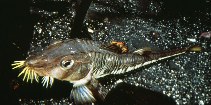| Family: |
Agonidae (Poachers), subfamily: Agoninae |
| Max. size: |
30.5 cm TL (male/unsexed) |
| Environment: |
demersal; marine; depth range 2 - 710 m |
| Distribution: |
North Pacific: western Bering Sea south of Cape Navarin to Commander Islands, and Pacific Ocean to Sea of Okhotsk off southwestern Kamchatka and northern Kuril Islands; eastern Bering Sea and Aleutian Islands from Attu Island to northern California at Point Reyes. |
| Diagnosis: |
Dorsal spines (total): 8-10; Dorsal soft rays (total): 7-9; Anal spines: 0-0; Anal soft rays: 6-9; Vertebrae: 39-42. Dorsal fins well forward and moderately separated; pectorals expanded, bottom 4 rays emarginate; pelvic fins reduced, in males length about equal to snout, in females half as long (Ref. 6885). Light grayish brown on dorsal surface, light yellow to orange on ventral surface; orange spot under each eye; dark saddle-like markings across back and sides; bright yellow on cirri; dusky on fins, dark blotch on posterior tip of anal fin in older individuals (Ref. 6885). |
| Biology: |
Common on soft bottoms (Ref. 2850). Feeds on worms, crustaceans, and small fishes (Ref. 4925). |
| IUCN Red List Status: |
Not Evaluated (N.E.) Ref. (130435)
|
| Threat to humans: |
harmless |
Source and more info: www.fishbase.org. For personal, classroom, and other internal use only. Not for publication.
